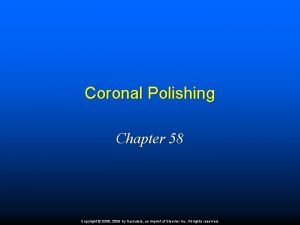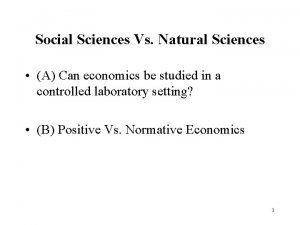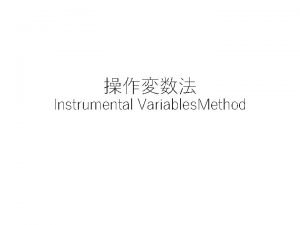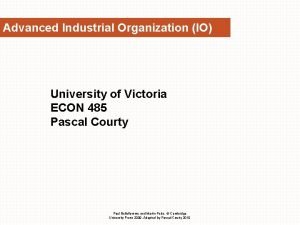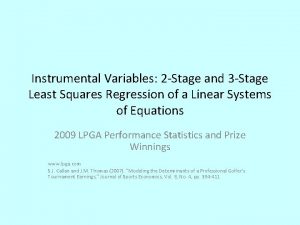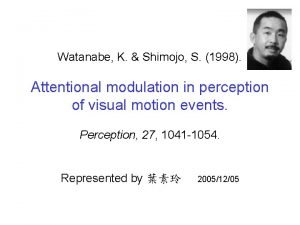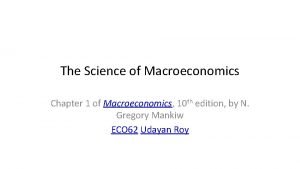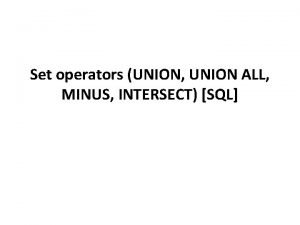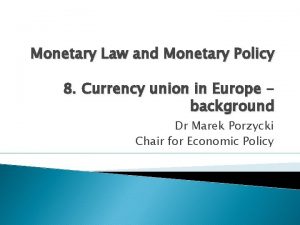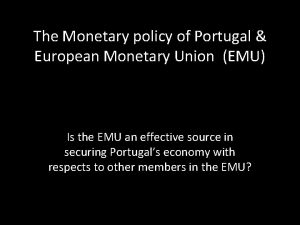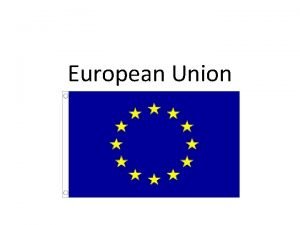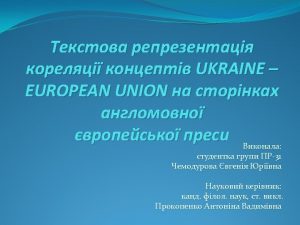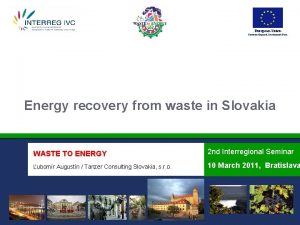Is the European Monetary Union an Endogenous Currency











- Slides: 11

Is the European Monetary Union an Endogenous Currency Area? The example of the Labor Markets Hubert Gabrisch, Halle Institute for Economic Research (IWH) gab@iwh-halle. de Herbert Buscher, Halle Institute for Economic Research (IWH) hbr@iwh-halle. de 1. 2. 3. 4. 5. 6. Content Unit Labor Costs and Trade Imbalances Theory of Endogenous Currency Area A Model for Testing Results Other Research Approaches Conclusions

The Theory of Endogenous Currency Areas - Real theory vs. monetary theory (convergence vs. currency area approach; this paper is not about convergence, therefore, some critical remarks in the final section; this paper is related to theory of OCA -The traditional version of theory of OCA (Mundel I) dominated the debate on EMU in the 1980 s and 1990 s: `first establish the pre-requisites, than unify the currency‘ Krugman‘s specialization hypothesis (1993); currency areas can fail (Cheikbossian, 2001): the problem of different inflation tolerances The methodology: Bayoumi and Eichengreen (1993): ‚Shocking Aspects of European Monetary Integration. ’ (business cycle correlation) - The German experiences. But remember: crowning vs. endogenity in the German debate! -The theory of ECA: Frankel & Rose (1998): The basic idea is that conditions of OCA need not to be fulfilled ex-ante of a currency union, but they emerge ex-post through single currency and common monetary policy. -Lucas critique (1976): a regime shift (in exchange rate regimes or, a currency union) will change the behavior of agents, and thus, the stability of coefficients in macroeconometric forecasting.

Unit Labor Costs and Trade Imbalances 150 Unit Labor Costs (1995=100) IT 140 GR IR PT ES 130 NL FR 120 BE FI DE 110 100 AT 90 80 2010 2005 2000 1995 1990 1985 1980 1975 Wage formation is a product of market processes and political intervention. This paper intends the testing of both!

What is new? - The theory of ECA has been tested and applied to EU business cycle synchronization only: - We apply the hypotheses of theory of a endogenous currency area to the EMU labor markets and test them, using the standard empirical methods of theory‘s empirical research program. - We also control for the intervention of governments, in particularly, in their ability to use indirect taxes for replacing social taxes (part of labor costs) - Standard approaches: analyse of bilateral correlation coefficients of labor cost developments, running a semi-structured model

The Model Bilateral correlation coefficients (logistic transformation) according to wage cost concept v and de-trending method s Wage cost concepts: ULC, NCE, RCE; de-trending: growth rates, HP, AR(2) Trade: bilateral trade intensity according to concept w: exports, imports, total trade: common currency enforces trade intensity (less transaction costs including exchange rate risks); hence, the presence of more foreign commodities of country i in country j strengthened the foreign sector in the domestic wage function. Theory predicts a ‚+‘ Finance: bilateral financial integration measured as relative difference between long- and short -run interest rates: common currency leads to more financial integration, hence, the balance of power changes to the detriment of labor. Theory predicts a ‚–‘. Special: Bilateral sectoral specialization index: Krugman hypothesis: more specialization = less correlation (sector specific wage shocks. Theory predicts a ‚-‘. TAX: controlling for political impact: relative share of indirect taxes in GDP: the higher the share the less wage cost developments are correlated: expect a ‚-‘! 3 sub-periods: 1981 -89, 1990 -97, 1998 -2007

Corelation coefficient analysis See Tables 1 -3 in the print-out (pp. 12 -13 Table 1: no clear picture, but evidence of declining number of significant cases Table 2: This evidence strengthens with respect to highly significant coefficients Table 3: We find a split between a Southern and a German (Northern) group: Intra-synchronization of wage formation is high in the Sourthern group, but broke down in the Northern group (above all in terms of NCE).

Regression results Export intensity ULC 81 -89 Import intensity 90 -97 98 -07 81 -89 Total trade intensity 90 -97 98 -07 81 -89 90 -97 98 -07 Constant -- -9. 949 -0. 274 -- -2. 140 0. 254 -- -8. 912 0. 411 Trade intensity -- 0. 960 0. 406* -- 0. 057 0. 108 -- 0. 756 0. 188 Sector specialization -- 9. 988* 1. 201* -- 6. 941* 0. 702 -- 0. 437* 0. 760* Financial integration -- -11. 815* -0. 380* -- -12. 347* -0. 365* -- -11. 847* -0. 346* Indirect Tax ratio (TAX) -- 3. 680* -5. 484* -- 3. 382 -4. 916* -- 3. 801* -5. 169* Adjusted R 2 -- 0. 802 0. 721 -- 0. 812 0. 927 -- 0. 798 0. 833 NCE Exports Imports Total Trade 81 -89 90 -97 98 -07 Konstante -- 0. 873 2. 443* -- -6. 101* 0. 342 -- -2. 571* 1. 983* Trade intensity -- -1. 314 -0. 111* -- -2. 943* 0. 068 -- -2. 643* -0. 058 Specialization -- 0. 733 0. 086 -- 1. 985* 0. 839 -- 0. 781* 0. 259 Finance -- -4. 543* 0. 522* -- -8. 231* 0. 453* -- -6. 292* 0. 530* Indirect Tax Rate -- 2. 226 -7. 371* -- 4. 263* -6. 6. 6* -- 1. 997 -6. 674* Adjusted R 2 -- 0. 762 0. 998 -- 0. 892 0. 900 -- 0. 836 0. 930

Conclusions We motivated our study with the ongoing debate on diverging labor costs and the role of national governments. We found evidence for an emerging split between a Southern and a Northern group of euro countries with respect to labor cost developments. We found only little evidence for theory of ECA. But, we found strong evidence of the impact of national tax policy. We conclude that more co-ordination of tax and expenditure policies between euro members would help to avoid (i) divergences in nominal wage costs, and (b) divergences in inflation differentials.

Other approaches I: convergence Fischer (2007), Deutsche Bundesbank (2007), Dullien & Fritsche (2007): long -run, equilibrium real exchange rate; ß-convergence, co-integration, error-correction model; related to growth theory: Open question: regime shifts might change the ‚convergence path‘ and intensity; the problem of short term deviations (Dullien & Fritsche).

Other approaches II: De. Grauwe (2006) Euro area? Symmetry C B OCA-2 A OCA-1 What is wage coordination? Flexibility of the labour market

Other approaches III: micro Third, our approach is different to the micro-economic view on the impact of a common currency on labor markets. the impact of a common currency on wage formation and labor market institutions from a single-country perspective (Soscice and Inversen, 2000; Calmfors, 2001; Traxler, 2002; Holden 2003; Mongelli and Vega, 2006; Andersen and Seneca, 2008); open question: what is the optimal degree of labor market flexibility? Hence, it is an approach to explain macroeconomic coordination/synchronization forced by the rigidities of a common currency via markets
 Chapter 58 coronal polishing
Chapter 58 coronal polishing Exogenous variables examples
Exogenous variables examples Neoclassical growth theory vs. endogenous growth theory
Neoclassical growth theory vs. endogenous growth theory Endogenous covariates
Endogenous covariates Advanced industrial economics
Advanced industrial economics Endogenous variables
Endogenous variables Endogenous attention
Endogenous attention Endogenous variables and exogenous variables
Endogenous variables and exogenous variables Intersect and minus in sql
Intersect and minus in sql This project is co-funded by the european union
This project is co-funded by the european union Borchert's epochs ap human geography definition
Borchert's epochs ap human geography definition Eurostars-3
Eurostars-3
